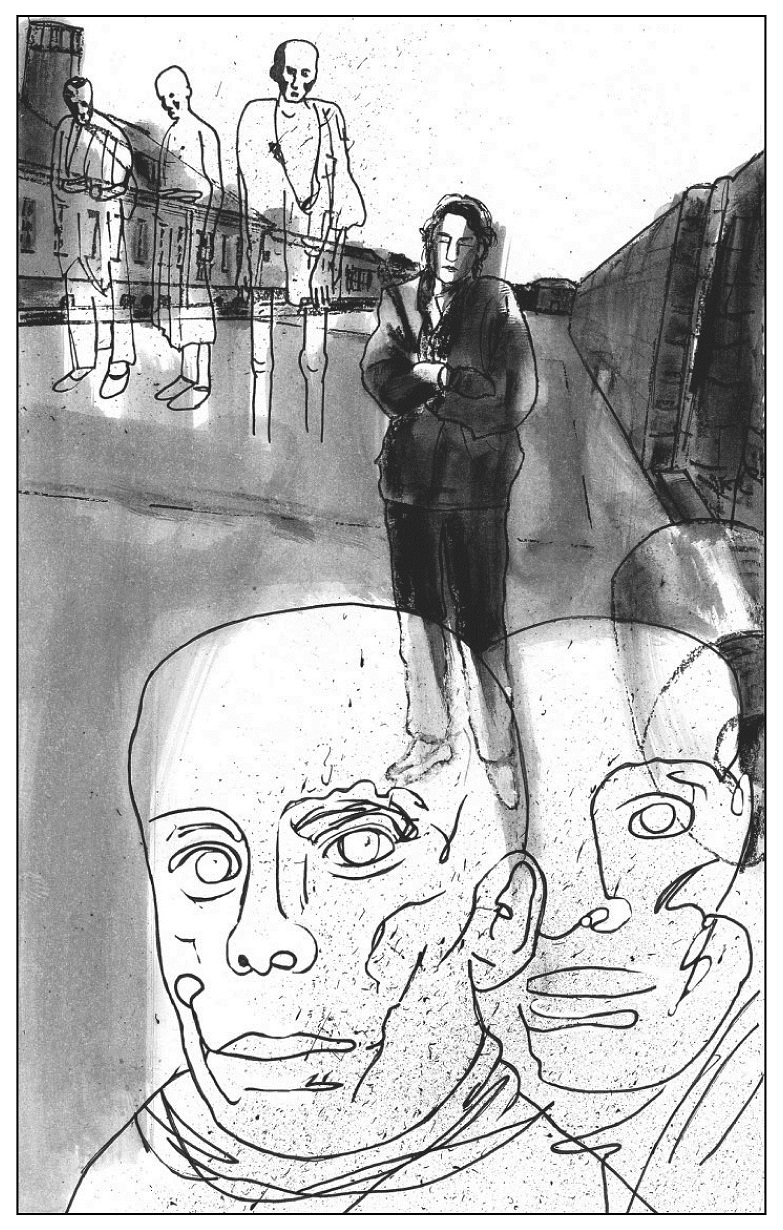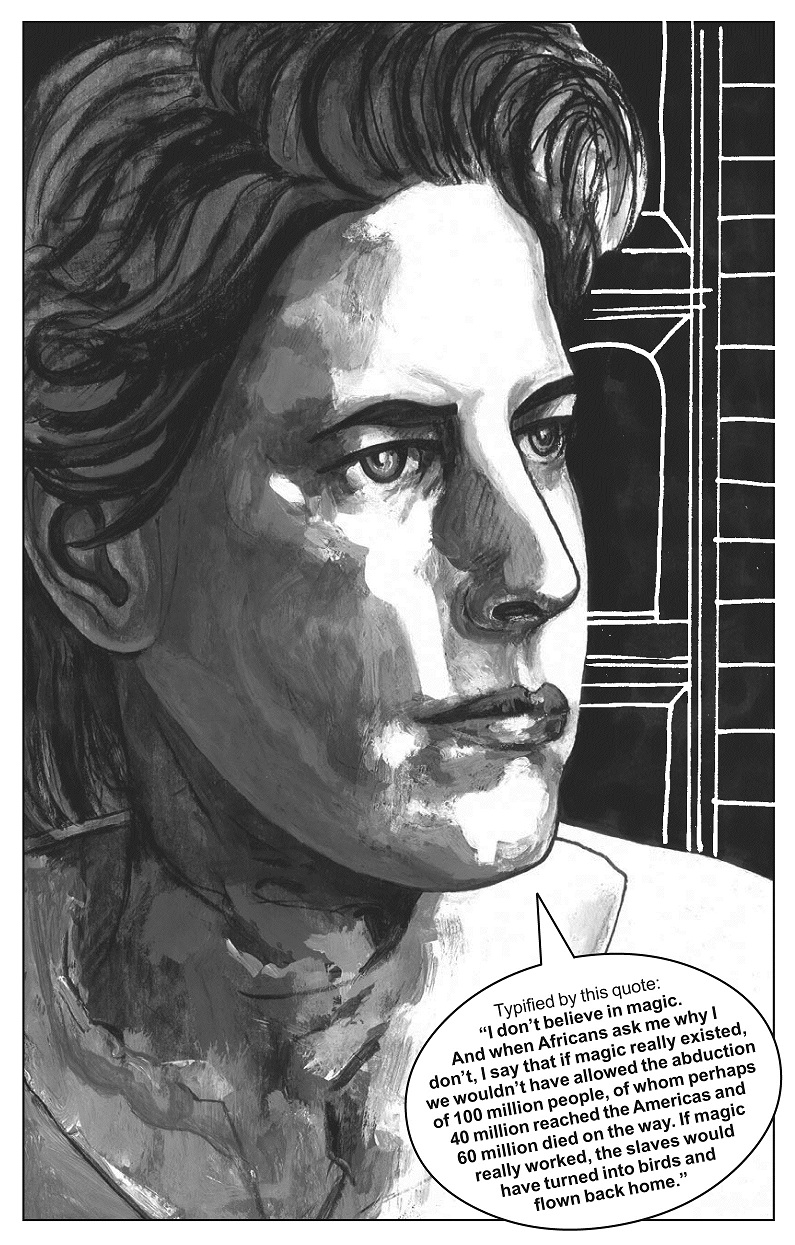 Title: The Listener: Memory, Lies, Art, Power
Title: The Listener: Memory, Lies, Art, Power
Author: David Lester
Publisher: Arbeiter Ring Publishing/AK Press Distribution
Price: $19.95
Vintage: April 2011
Genre: OGN, art, history, politics
What is The Listener graphic novel about? From The Listener Graphic Novel’s Blog:
THE LISTENER reveals one of the world’s most tragic acts of spin doctoring while weaving a compelling tale of complacency, art, power, and murder. It is a startling little-known story that changed the course of history. In THE LISTENER, two stories collide: the rise of Hitler and a woman artist searching for meaning in the great art of Europe.
Spin doctoring didn’t start with “weapons of mass destruction” to justify an invasion of Iraq. No, one of the original spin doctors was Adolf Hitler, who turned a narrow electoral win into a “massive victory” that paved the way to power and world war. If you liked Joe Sacco‘s Footnotes In Gaza; Jason Lutes‘ Berlin books; Marjane Satrapi‘s Persepolis; Art Spiegelman‘s Maus; Margaret MacMillan‘s Paris 1919; or Ari Folman‘s film Waltz with Bashir, then you’ll love THE LISTENER.
In The Listener, the artist Louise goes on a sabbatical across Europe to escape the guilt and sadness brought on by the death of a young activist who was inspired by one of her sculptures to hang a protest banner off a tower, where he slipped and fell to his death. Haunted and troubled by this event, she embarks on a journey to explore the plethora of museums scattered across the continent of Europe, re-exploring famous and favorite paintings and sculptures. The politics behind these works of art swim in her mind. Along the way, she meets various people who affect her life. In the Netherlands, she meets Alex. Alex enjoys explaining the history of everything he sees, and through his words we learn the history of several works of art. In Austria, she meets Tomas, a man interested in the people behind the works of art, specifically destructive people who were artists or poets (Hitler as a painter, Stalin and Mao as poets). They visit a concentration camp together, where Louise struggles to absorb the atmosphere of the place, but is unable to comprehend the magnitude of what occurred there. Tomas recounts mundane events that were going on while millions of people were murdered. As they journey through Europe, they discuss with each other how they became artists, and what inspires them. There are some nice sketches of a man’s naked rear (thank you, Mr. Lester), followed by a discussion on the understanding of art (do people see what they’re meant to see, learn what they’re meant to learn, or see what they already understand), and artists’ obligation to the world around them. Of particular note is a story about Orson Welles who was asked to run for senate (I don’t know that this actually happened, though he was a political activist), declined, and Joseph McCarthy won that election. We all know what happened then. As Louise travels she receives letters blaming her for the death of the previously mentioned activist. She begins to wonder if it’s better to just create popular art rather than something with a message.

Interspersed with Louise’s story, is the story of Marie and Rudolph. Along her journey, Louise runs into this older couple, and in exchange for a sketch, the couple tells their story in flashback scenes. Marie and Rudolph work for a newspaper in the conservative state of Lippe in Germany, in the 1930s. They join the DNVP (German National People’s Party), which desires the return of the monarchy in Germany. The world slowly begins to change around them, and the Nazi party grows and uprisings against the Jewish people increase. A delicate election is approaching, which will determine the new chancellor of Germany. The top picks are DNVP’s Hugenberg (who owns the paper where Marie and Rudolph work) and Adolf Hitler. Things aren’t looking good for the Nazi party, as their voter numbers have been decreasing, and Hitler’s stubborn desire to hold all the power in his hands or none at all is hurting the party. Hugenberg eventually strikes a deal with Hitler, under the guise of national unity, hoping for a position of power in a Nazi run government. Marie and Rudolph’s paper is ordered to cease attacks on the Nazi Party. Hitler’s party continues to struggle, so he finances a new campaign, centered in Lippe. His soldiers parade across Germany and cover up DNVP posters with Nazi propaganda. Local rallies are manipulated and members of the opposition are brutally attacked at their own rallies. Newspapers backed by the Nazis spread their progaganda, while the DNVP silences its own papers and reporters, shuts down its rallies, and allows the Nazis to fill their political space without protest. On election day, the Nazis win Lippe by almost the exact amount of votes the DNVP lost. Hitler’s rise to power is assured, and the changes are both immediate and gradual. Political parties are banned, the DNVP is dissolved, opposition leaders are found dead, citizens suspected of being Jewish or communist are beaten, newspapers with anti-Hitler opinions are banned, persecution of the Jews escalates. The victory in Lippe becomes an annual celebration, and Hitler purports himself as Germany’s hero. At the end of their story, Marie and Rudy express their regrets for not having done more, and Louise returns home with their memories and a special gift.
Back home, Louise is even more lost than before, and slips back into her lifestyle before her journey, even returning to the man she had broken up with. As if her experiences across Europe never happened. After some time passes, a man named Walter, an acquaintance of the man who died way back at the beginning of the comic, visits Louise. He tells the story of how he met Vann, a Cambodian doctor who survived a smaller genocide than the Jewish Walter, but who lost his parents and was never able to overcome his survivor’s guilt. Vann took to art with great interest, wondering what made artists so dangerous that so many had had to die. Rather than come to blame Louise for Vann’s death, Walter has come to tell her that Vann was inspired by her work, but that the decision that led to his death was Vann’s and Vann’s alone. Louise is moved by the story, and Walter’s words about the big impact the smallest thing can have on someone’s life. Meanwhile, in Germany, far-right-wing activities are erupting in violence, including anti-Semitic activity. With the story of Marie and Rudolph, which resurfaces in her mind, Walter’s story, and the current events, Louise is inspired to create a new sculpture that is the culmination of all she learned on her journey through Europe.
Art is often seen as a beautiful, peaceful way of expression and viewing. It’s not often that “artists” are mass murderers or power hungry dictators (it is a remarkable addendum that one of Hitler’s last requests was for a museum to house his collection of paintings). The stereotypical artist is a “beautiful soul,” putting passionate feelings to canvas, print, stone, or song. It’s hard to believe that a Walt Whitman or a Georges Seurat would systematically murder an entire race of people. Even for social/political writers like Victor Hugo or Charles Dickens. And while I wouldn’t say that Hitler was a Van Gogh (if he was, then history may have been quite different), there’s a certain spirit in someone who interprets and creates. It’s depressing to think that someone who enjoys expression and creation could so love destruction. I should say that it’s difficult for me to write Hitler off as anything other than a delusional, paranoid, psychopath. The man was obsessed with his image as a hero for Germany. Indeed, he likely saw himself as Germany’s new Siegfried, the Motherland’s hero come to destroy the Nibelungs – the Jews. But it’s impossible to deny his artistic “flair,” or the way in which he and his Party so skillfully maneuvered a victory. Lester inserts several images and quotations of the propaganda used by the Nazis. Reading some of this actual Nazi propaganda can really shake you up. The vitriol is truly horrific and saddening. The xenophobia is rampant. It ignited an entire nation and motivated the murder of millions.

There’s a LOT of quoting of various artists or speakers by the characters (though Lester also uses many excellent quotes as chapter headings), and at first I thought, real people don’t talk like that. Well, normal people don’t. People who live in art do. Artists aren’t exactly “normal.” Have you ever known an artist who was totally unscathed by life? Would there have been a Charles Dickens if he hadn’t experienced first hand the horrible conditions of London’s factories as a child? In the same way that comic geeks quote Joss Whedon, and sci-fi geeks quote Star Trek, literary geeks quote Shakespeare, and art junkies quote Picasso. When you live and breathe that stuff on a daily basis, it becomes a central part of your life even outside its most practical uses.
On Louise, I like how she is much more comfortable expressing and explaining herself through drawing. I’m much the same with the written word. She is also a listener (hey, lookie there) and an observer, absorbing everything around her. Specifically in this book, she listens to Marie and Rudolph’s story, their last bit of “activism,” imparting their story and embedding its lessons into another. She runs from her guilt, even as it chases her every step of the way, and only when she finally faces herself and absorbs Vann’s actions is she able to move forward and create her masterpiece.
The Listener is a good story for people familiar with artists and art movements, as such things are thrown around all over the text. I’m more familiar with written works of art, and don’t have much knowledge of surrealist paintings, or the impressionist movement. So much of that goes over my head. Lester slips these things, their history, their impact, into conversations between his characters, and ingrains them into their lives. You won’t see much art here, as Lester chose to leave a trail of blank canvases across the pages, leaving Louise to impart her thoughts on pictures we never see (Perhaps the history and meaning is more important? Or perhaps it is just a style choice.). As for Lester’s art, it sweeps across the pages, changing as if it is alive with his thoughts. It is far from a traditional comic book, and though I don’t want to label it as “artsy-fartsy,” it is highly artistic. Unfortunately, the text bubbles and the text font are somewhat detracting, at least at first. The choice there takes some getting used to, but eventually it blends in with everything else on the page. As someone with an interest in the psychology of Hitler and the propaganda machine that was the Nazi Party, The Listener proved to be an intriguing read. This isn’t something you can flip through in an afternoon. I spent hours going through the book, taking notes, forming thoughts. As for its accuracy, it has been stylized of course, but the campaign in Lippe did happen. Much of the dialog from Hitler (and some from his officers) contains direct quotes from his speeches and writings. Lester details what is historical fact and what is his own making in the back of the book, which also includes an excellent timeline of the rise and fall of the Nazi Party. Another nice inclusion is a collection of small biographies of several Nazi (or at least, people hired by them, if not actual Nazis themselves) animators, film makers, and cartoonists, detailing their specific involvement in the Nazi propaganda machine, and their lives after the fall of the Third Reich.
In America, The Listener will be distributed by AK Press Distribution (out of California), ISBN: 9781894037488. In Canada, by LitDistCo. In the UK, by Global Book Marketing. The Listener will be available in April 2011.
Editor’s Note: ComicAttack.net has been officially nominated for an Eagle Award! Please click here to vote for us in the “Favorite Comic Book Website” category (question #27). Thank you for your continued support!
Kris
kristin@comicattack.net
@girlg33k_Kris
A copy of The Listener was provided by Mr. David Lester for review. Images used with permission of David Lester, from The Listener Graphic Novel’s Blog.




Sounds like a complex, but also interesting read. Nice review Kris!
It was a good read, Billy. Lots of depth, lots of great imagery.
Who is The Listener?
David Lester talking about The Listener. More videos on The Listener on Vimeo.